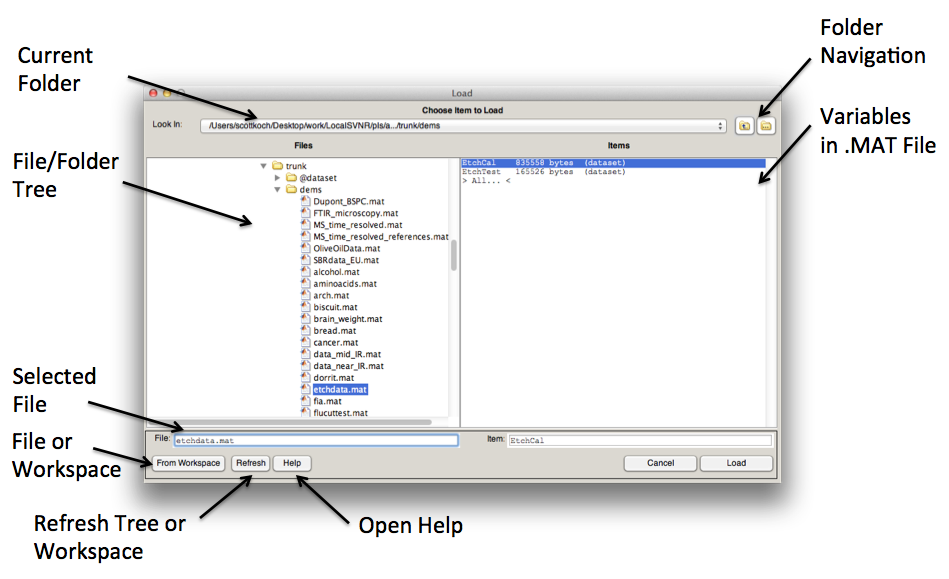Loading and Saving: Difference between revisions
imported>Jeremy |
imported>Jeremy No edit summary |
||
| Line 1: | Line 1: | ||
==Loading From the Workspace and MAT Files== | ==Loading From the Workspace and MAT Files== | ||
Solo and PLS_Toolbox save in the native MATLAB binary file format called a MAT file. This format is compact and quick to read and write, but is, obviously, not compatible with other programs | Solo and PLS_Toolbox save in the native MATLAB binary file format called a MAT file. This format is compact and quick to read and write, but is, obviously, not compatible with all other programs. There are a number of options to Import and Export data and models to other formats. | ||
Solo and PLS_Toolbox also make use of a "workspace" which is a memory-only space to store data, models and other objects. This workspace only exists when the program is running and will be cleared when the program is exited. | Solo and PLS_Toolbox also make use of a "workspace" which is a memory-only space to store data, models and other objects. This workspace only exists when the program is running and will be cleared when the program is exited. | ||
| Line 13: | Line 13: | ||
==Importing From Other Sources== | ==Importing From Other Sources== | ||
Data can be imported from a variety of sources using '''File>Import Data''' | Data can be imported from a variety of sources using '''File>Import Data'''. See [[Data Importing Formats]] for more information on these formats. | ||
==Saving and Exporting Models and Data== | ==Saving and Exporting Models and Data== | ||
| Line 42: | Line 22: | ||
For more information on Exporting models see: [[Exporting Models]] | For more information on Exporting models see: [[Exporting Models]] | ||
Revision as of 10:54, 2 August 2010
Loading From the Workspace and MAT Files
Solo and PLS_Toolbox save in the native MATLAB binary file format called a MAT file. This format is compact and quick to read and write, but is, obviously, not compatible with all other programs. There are a number of options to Import and Export data and models to other formats.
Solo and PLS_Toolbox also make use of a "workspace" which is a memory-only space to store data, models and other objects. This workspace only exists when the program is running and will be cleared when the program is exited.
Load and Save operations to either MAT files or the Workspace use a common interface. This interface can be used to switch between workspace and file modes using the button located in the lower left corner. The Workspace view allows you to save or load directly to/from the current Workspace; The File view allows you to save or load directly to/from a .mat file.
In File view, the controls at the top of the window allow for standard folder navigation. The two list boxes, Files and Variables, show, respectively, the available files in the currently selected folder and the available variables in the currently selected .mat file. Note that a .mat file can contain several variables and you can select one or more from the Variables list to load. When saving to a .mat file you must name both the file and the variable (i.e., both the File and Variable text boxes must have values in them). Also notice that in the Files list a name preceded with “[ ]” indicates a folder. To navigate into any folder, either double-click the folder name in the listbox or select it and click the Open button.
Importing From Other Sources
Data can be imported from a variety of sources using File>Import Data. See Data Importing Formats for more information on these formats.
Saving and Exporting Models and Data
Save/Export functionality can be found in the File menu. All data objects (datasets, models, and predictions) can be saved in .mat files or exported to CSV or XML from the File menu of the DataSet Editor. Models can be exported as XML or m-files from the File menu in Analysis as well as several other formats (depending on the model type and purchased program options.)
Again, remember that the program Workspace is volatile and will be cleared when you exit the program.
For more information on Exporting models see: Exporting Models
